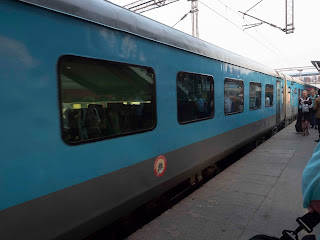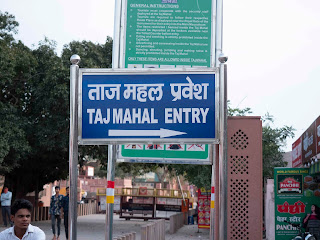Day 4: Agra
Up and out early this morning to catch an 8 am train to Agra, home to the Taj Mahal. The train station was a crush of humanity with thousands of people coming and going. The train to Agra was, amazingly, on time, and completely civilized (if not a bit worn). It helped that we had reserved seats in 1st class and had Hemesh herding us.
With no stops between Delhi and Agra, we got to Agra in under 2 hours. Agra, though a huge tourist city, seems significantly poorer than Delhi with buildings along the main roads in various states of disrepair, and many more outright beggars (compared to the beggars in Delhi that tried to sell you something or entertain you).
Since our hotel rooms would not be ready for several hours, we hit the ground running and began to explore Agra. First stop, I'timād-Ud-Daulah tomb, a.k.a. the “Baby Taj” built in 1622 by the Empress Nūr Jahān for her father, Ghiyas Beg (later known as Itmad-ud-Daulah)
It is the first tomb in India built entirely in white marble. The tomb is also justly famous for the glorious pietra dura (stone inlay) decoration depicting cypresses, wine glasses, and an amazing variety of geometrical figures. Due to the profusion of intricate inlaid marble and the beautiful marble screen-work, the tomb is considered the forerunner of the Taj Mahal.
We next visited the famous Agra Fort. Built by Mughal emperor Akbar in 1565, Agra Fort is a majestic sandstone structure 2.5-km square enclosing the old imperial city. The fortress is shaped like a crescent, its eastern wall flanked by River Yamuna. The construction of the fort was originally begun by emperor Akbar, but completed by his grandson Shah Jahan, who added most of the marble monuments here.
As you enter the fort, the first major structure is the hall of audiences where the emperor would hear petitions from commoners. Adjacent to this, through a gate, is the palace built for Jodha Bai, said to be Akbar’s favourite queen.
 |
| View of the Taj Mahal from the tower |
 |
| View of the Taj Mahal from the tower |
We checked into our hotel, grabbed a bite to eat, and took off for the piece de resistance, the Taj Mahal. It is considered by many as the most beautiful building constructed by man. The monument was built as a memorial by Mughal emperor Shah Jahan for his deceased wife, Mumtaz Mahal. It is one of the seven wonders of the world. Its name is believed to have been drawn from the Persian language: ‘taj’ means crown and ‘mahal’ means palace, thus making this the palace of the crown.
The structure looks the same from all four sides, except the one that faces River Yamuna. This side served as the main entrance for the emperor. Shah Jahan would approach the Taj Mahal from the river, aboard a barge, while our entrance served, at that time, as an entryway for soldiers and common people.
 |
| Entry gate |
There are intricate inscriptions on all four entrances, while marble carvings and pietra dura mosaics adorn the walls.
 |
| Inscriptions from the Koran inlaid with onyx at the gate |
Lapis-lazuli, cornelian, mother of pearl, agate and emerald are some of the precious gems and stones that were once used in its design. It is said that work on its construction began in 1631. Legend has it that it took 22 years to complete. To commemorate the 22 years of construction, there are 22 cupolas scattered around the entryways and the monument itself.
 |
| Initial glimpse of the Taj Mahal through the gate is breathtaking |
The Taj Mahal has optical illusions and masterful architectural safeguards built in. From the main gate, the Taj Mahal looks enormous, but as you move closer, it appears to shrink in size. Also, the minarets surrounding the Taj, while perfectly upright to the naked eye, have actually been constructed to lean away from it so that, should a disaster like an earthquake come about, they would fall away from and not on the mausoleum.
The reflecting pool is a main attraction and we had to fight for a good position to take pictures. Trump had it easy when he went; they closed the place down for him. Glad we weren’t here then!
The mausoleum is flanked by two identical buildings; to the left, a mosque (still active with prayers on Fridays), and to the right, a hotel of sorts for pilgrims coming to pay respects to the deceased queen (the hotel is no longer in function).
In order to enter the Taj Mahal, we were required to remove our shoes or cover them. Hemesh procured 10 pair of shoe covers for us saving us from another gross out.
no photos were allowed, but we got to see the beautiful white marble carved screen, inlaid with semi-precious stones. The marble is one of the world’s finest and densist, mined in Makrana, 450 km from Agra. The huge blocks were then carted by camel or elephant to the construction site. The marble was decorated using pachi kari (pietra dura), an ancient technique for inlaid stones. It is so well done, that it appears to be painted.
As the sun began to set, it looked like the light would be spectacular,
but unfortiunately, it clouded up and become overcast. The light got very flat not giving us the lighting and colors we had hoped for.
We’ll have to keep our fingers crossed for a good morning tomorrow.




















































No comments:
Post a Comment